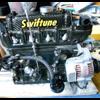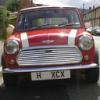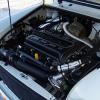
Correct Tyre Pressure For 13'' Yoko A048's
#1

Posted 27 August 2008 - 08:35 AM
Cheers
Ben
#2

Posted 27 August 2008 - 08:02 PM
#4

Posted 28 August 2008 - 08:19 AM
If youre going to be using the car for road use i'd say try a tad over 30psi, say 33psi and perhaps drop them abit if youre go for a blat on a circuit.
Might be splitting hairs but it makes a difference to race cars so why the hell not!
#5

Posted 28 August 2008 - 09:08 AM
#6

Posted 28 August 2008 - 09:58 AM
#7

Posted 28 August 2008 - 05:41 PM
Factory tyre pressures are 28 on the front and 26 on the rear
#8

Posted 28 August 2008 - 05:45 PM
Not that I know the answer, but you always hear Motorsport teams ( especially F1 ) bangin' on about tyre pressures
#9

Posted 28 August 2008 - 06:00 PM
Which would be better? Obviously I know the handling is abit rubbish with 13x7... but what pressure would improve it?
#10

Posted 28 August 2008 - 08:36 PM
#11

Posted 28 August 2008 - 10:11 PM
anybody?
I reckon higher pressure would reduce the contact surface area on the road (marginally) and make the car both faster (less friction fro surface contact, not noticable really) but mainly more responsive in corners but you'd probably forfeit some grip and you'd get a harder ride. It's much of a muchness though unless ur no a track
This is all from riding vespa's though, but i reckon some of the principles are transferable
#12

Posted 29 August 2008 - 07:40 AM
On 13" minilites and a539's we found that when the cold tyre pressure was set to the reccomended pressure of 30psi, the tyres performed best once warmed - at which point the pressure was 38psi due to the air expanding with the heat.
We then lowered the cold tyre pressures in 5psi increments to 10psi and noticed how the car behaved at each point. The car was driven around a skid pan in circles one way and then the other. The driver was asked to push the car on the limit of grip and try to stay on the line around the skidpan. We had a steering and throttle data logger of each seperate run and got feedback from the driver who's a regular hillclimber.
As you would think, the lower the tyre pressure the less responsive the car became and understeer became worse with each pressure drop. Like someone said above, with the lower pressure there is more of a footprint of rubber in contact with the road, especially sidewall flex at lower pressures, this results in alot of grip and in turn friction so this creates understeering characteristics!
A warm tyre pressure of about 38psi should be aimed for on trackdays etc, as this is a decent balance between the amount of footprint giving you grip, but not too much to have a detremental effect on the handling characteristics - in short, these are the pressures that the peformance tyres where designed to be used with.
With drag racing you run lower pressures to increase tyre contact, to give you the grip off the line instead of spinning the wheels at a higher pressure. But on a track you have to go round bends and want the car to be agile through the corners.
Found this direct on the Yokohama site, accurate to what I said originally at 33psi
The ADVAN A048 needs to operate in the 33 to 36 psi window for maximum performance. So you have to figure out how to make your tyres reach this window when you need maximum performance. A hillclimb car may start with tyre pressures in the window because the tyre pressures are unlikely to climb very high in a short 40 second run with no warm-up lap. A big heavy car like one of the Yokohama V8 racing utes competing in a 10 lap race may start with a pressure of 28psi. The big heavy high horsepower car is going to work the tyres hard so the tyres will build a lot of heat. As the air in the tyres expands the pressure goes up. So the ute may reach the pressure window by lap 3! The first step to figuring out the best tyre pressures in your ADVAN A048s is to start with a tyre pressure you think will rise beyond the operating window then go out on the track and do your normal race distance. Come straight in and bleed pressure out of the tyres so they come back to say 35psi which is in the middle of the pressure window. Then let the tyres cool completely and measure their cold pressure. This is a good indication of what your starting pressure should be. Further refinements can be made by measuring the tread surface temperature variation with a pyrometer and adjusting starting pressures depending on track and ambient temperatures.
Cheers
#13

Posted 29 August 2008 - 07:58 AM
#14

Posted 29 August 2008 - 09:09 AM
#15

Posted 29 August 2008 - 09:39 AM
1 user(s) are reading this topic
0 members, 1 guests, 0 anonymous users


















